What is a dead zone?"Dead zone" is a part of an aquatic system in which the level of oxygen in the water is so low that cannot sustain life. Less oxygen dissolved in the water transforms rich habitats in biological deserts. Dead (hypoxic) zones can occur naturally but the last decades their number and size increased worldwide in areas of intense human activity. How many dead zones exist?More than 500 areas have been identified and recorded as dead zones. The majority is located in North America followed by Europe and Asia. Their number increased rapidly since early 70s. The majority of them are located in areas where natural enrichment of the coastal waters is intensified by human activities such as agriculture or industry. Over the last 50 years, problems related to over-fertilization of the sea and low dissolved oxygen expanded to the point where large areas devoid of fish, shrimp, and crabs are common occurrences. These dead zones, or oxygen deserts, are very damaging to the environment and also to people that rely on the sea for their livelihood. |
|
|
|
|
What causes dead zones?Agricultural practices are the biggest culprit in the United States and Europe. Sewage causes the majority of dead zones in Africa and South America. In both cases phosphorous and nitrogen arriving in the aquatic ecosystems feed marine phytoplankton which dies and is decomposed by bacteria consuming oxygen for their respiration. Thus excessive enrichment of the water leads to consumption of the dissolved oxygen leaving very little oxygen in the subsurface waters. Without oxygen, most marine life cannot survive resulting in a dead zone. Natural processes, such as the churning of ocean waters, can also form dead zones on their own. Upwelling of nutrients introduce algal blooms. As the algae die and settle, they create hypoxic areas. The last years scientists detected dead zones also in the open ocean. Can dead zones be brought back to life?Yes, but needs efforts. The Black Sea once hosted one of the largest hypoxic zones in the world, stretching 15,000 square miles. When agricultural subsidies from the Soviet Union collapsed in the late 1980s, fertilizer runoff dropped by more than 50 percent. The waterways took three years to recover and international support for runoff management has helped keep the Black Sea alive and well ever since. The key to reducing the size and number of low-oxygen dead zones in coastal waters is to reduce the input of nutrients into estuaries and the coastal ocean. |
|








